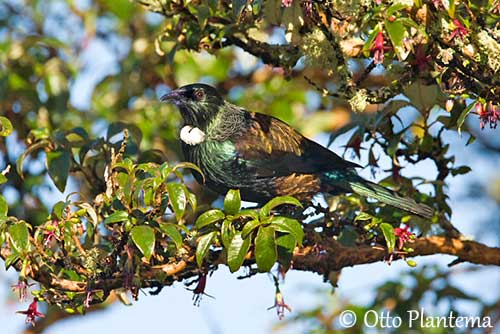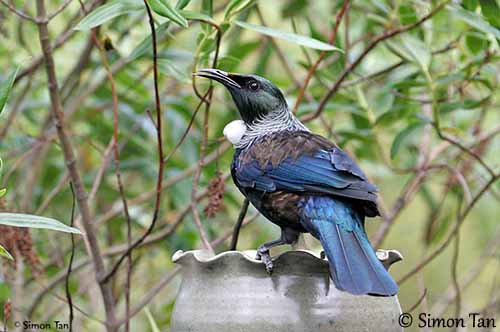
Fr: Méliphage tui or Tui cravate-frisée
All: Tui
Esp: Mielero Tui
Ita: Tui
Nd: Toei
Sd: Tui
Photographers:
Ken Havard
My Bird Gallery & Flickr gallery 1 & Flickr gallery 2
Patrick Ingremeau
TAMANDUA
Otto Plantema
Trips around the world
Simon Tan
PBase Bird galleries
Text by Nicole Bouglouan
Sources:
HANDBOOK OF THE BIRDS OF THE WORLD Vol 13 by Josep del Hoyo-Andrew Elliot-Jordi Sargatal - Lynx Edicions – ISBN: 9788496553453
KNOW YOUR NEW ZEALAND BIRDS by Lynnette Moon - New Holland Publishers – ISBN: 1869660897
L’ENCYCLOPEDIE MONDIALE DES OISEAUX - Dr Christopher M. Perrins - BORDAS - ISBN: 2040185607
BirdLife International (BirdLife International)
New Zealand birds and birding (Narena Olliver)
Wikipedia, the free encyclopaedia
Tui
Prosthemadera novaeseelandiae
Passeriformes Order – Meliphagidae Family
INTRODUCTION:
The Tui is a forest bird well known for its songs often heard before dawn. This species is endemic to New Zealand. It is a nectar feeder and an important pollinating species. It is common throughout its range.
DESCRIPTION OF THE BIRD:
Biometrics:
Length: 27-32 cm
Weight: M: 62-150 g – F: 58-105 g
The adult male of nominate race has glossy black head, underparts, wings and tail, with iridescent blue and green sheen, mainly on head and wings. There is a conspicuous white patch on shoulders, more visible in flight.
Upper back and flanks are dark brown with bronze sheen, whereas lower belly, thighs and vent are black-brown with yellowish-brown wash on lower belly and vent. The undertail-coverts are iridescent dark green to dark blue, and the undertail is black. The underwing is blackish with slight dark green to dark blue iridescence on the leading edge.
The colours of the plumage may vary with the light.

We can see a conspicuous pair of white, rounded tufts formed by curled feathers on the sides of the throat. There is a lacy hindneck-collar formed by filamentous white feathers which extends to the neck sides and the upper mantle.
The sturdy, slightly decurved bill is black to black-brown. The eyes are dark brown. Legs and feet are black to greyish-black.
The adults have a notch on the 8th primary, creating a whirring sound in flight. Male and female have similar plumage, but the male is larger than the female.
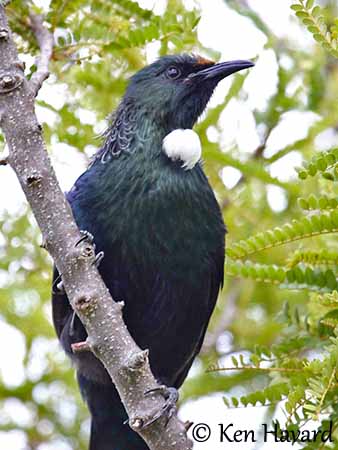
The juvenile is duller, blackish-brown to grey-black, with greyish throat and a pale patch instead of white rounded tufts. There is often a faint dark green to dark blue iridescence on scapulars and uppertail-coverts. Head, upperparts and breast are finely pale-streaked.
SUBSPECIES AND RANGE:
P.m. novaeseelandiae (here described and displayed) is present and widespread to locally abundant on North, South and Stewart Islands and the offshore islands. It is also present on Kermadec and Auckland Islands.
P.m. chathamensis is endemic to the Chatham Islands. This race is larger and heavier than nominate (Weight: M: 90-240g – F: 90-170g). Its plumage shows slightly bluer iridescence, but never any straw-yellow sheen like nominate.
HABITAT:
The Tui is found in native forest and scrub, including exotic forests. It can be seen in rural and suburban gardens, parks, stands of flowering trees and sometimes in orchards.
This species occurs mostly at lower elevations, but some records indicate 1500 metres. It breeds in native forest and scrub. They are locally abundant in areas where they can find many flowering plants and fruiting trees for feeding.
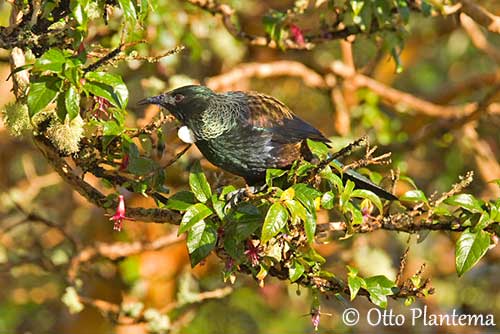
CALLS AND SONGS: SOUNDS BY XENO-CANTO
The Tui has loud, complex and varied songs, mix of melodious notes interspersed with noises such as coughs, grunts and wheezes, but also bell-like “bong” sounds, cries, gurgles and whistles, usually leading to a rich, fluid trill.
Duets by pairs are recorded too, in unison or alternating.
The alarm calls vary from high-pitched “ke-e-e-e” and loud piercing shriek, to scolds and guttural squawks.
The Tui also mimics numerous bird species living around it.
In flight, a loud whirring “whurrup” noise is produced by the notch on the 8th primary. This noise is mainly heard during displays and aerial chases, with bill-clicking too.
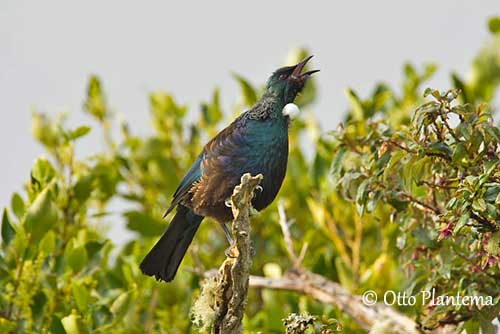
BEHAVIOUR IN THE WILD:
The Tui is a honeyeater, and feeds primarily on nectar and honeydew, but it also takes insects, spiders, cicadas and wasps as supplementary food. Moths are caught on the wing.
Seasonally, it consumes fruits, especially during autumn, from several plant species, and occasionally seeds and pollen.
It takes the nectar from forest flowering trees and shrubs, and extracts the nectar with its long, brush-tipped tongue. It may hang upside down to sip nectar from some hanging flowers. The male feeds more extensively on nectar than the female.
It also eats forest berries, and in the same way, it disperses the seeds and pollinates the flowers as it carries pollen on the bill.
Insects are gleaned from the vegetation or caught in aerial sallying.

The Tui forages alone or in pairs, and sometimes in family groups. Numerous birds may gather at abundant food sources in flocks of up to 200 individuals.
They usually defend their feeding territories or part of them, and can become very aggressive. They chase intruders away from their feeding area with loud whirring wings. They attack with the sharp bill, and often erect their plumage to appear larger as intimidation display.
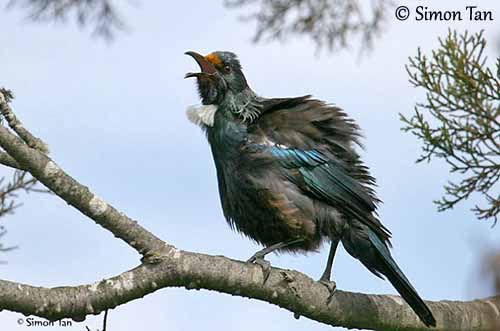
The Tui performs a display flight, flying upwards above the canopy, and then, diving back into the trees by noisy, near-vertical dive. Both mates sing duets to strengthen the pair-bonds.
The male strongly defends the nesting territory and is usually aggressive against intruders of any species, even larger ones.
The Tui appears partly migratory, but with local movements according to food resources.
It performs strong, rapid flight, with a whirring sound produced by the wings.
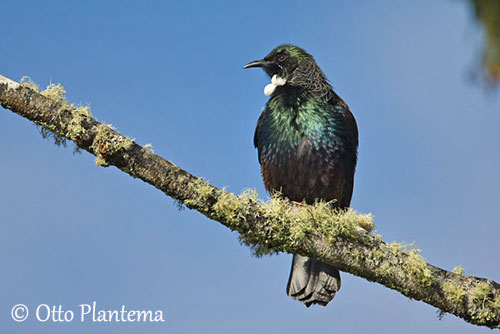
REPRODUCTION OF THIS SPECIES:
The breeding season occurs between September and January, but it may vary according to the start of nectar production in each region.
In Chatham Islands, the laying occurs from mid-November to early-December. The young fledge late December to late January. Two broods can be produced in a season.
The nest is built by the female. This is a bulky structure made with sticks and dried grasses, and lined with feathers and soft grasses. It is placed in tree fork or dense scrub, usually between 2 and 24 metres above the ground (1,5 – 6 metres in Chatham Islands).
The female lays 2-4 white to pale pink eggs with darker markings. She incubates during 12-15 days and broods the chicks. However, the male takes part in feeding the chicks on nectar, berries and insects. They fledge about two weeks after hatching. The male still feeds them while the female lays a second clutch.
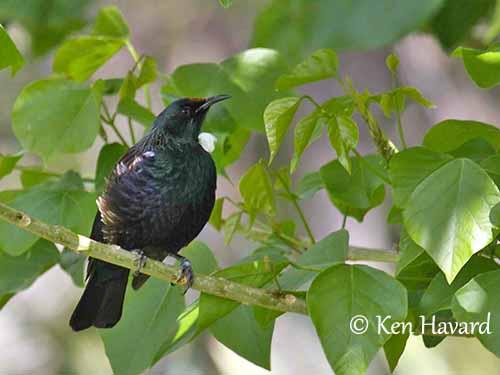
PROTECTION / THREATS / STATUS:
The Tui is widespread in most part of the range, from abundant to common according to the location. It is fairly common in Chatham Islands.
Declines occurred throughout New Zealand in 19th century, probably due to the clearing of lowland forest, and in Chatham Islands, to the clearance of the coastal vegetation for agriculture expansion. It was formerly hunted for food, and often kept as pet, very appreciated for its mimicry.
The Tui is not currently threatened, with a population estimated at 3,500/15,000 individuals, and it has large range.
